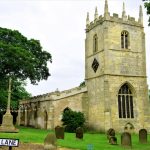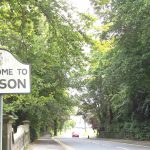Stenhousemuir: The Five Minutes Spare Guide
The Lowland town between Stirling and Larbert.
Stenhousemuir started life as a small village bordering Larbert and northwest of Stirling. Situated in the picturesque Forth Valley, where the River Carron runs past, this is a pretty small town ideal for visiting in the summer months.
We took the five-minute tour around Stenhousemuir to report back on all the good things we found there. Then there’s a little bit of Stenhousemuir history, followed by some other fun facts. So without further ado lets get this tour on the road…
Planning Your Visit
Best Time to Visit
Stenhousemuir is lovely year-round, but Scotland being Scotland, you’ll want to time your visit carefully. Late spring through early autumn (May-September) offers the best weather for exploring the Ochil Hills and outdoor attractions. Summer months are perfect for the Falkirk Tryst (the massive livestock market) and wandering the countryside without getting properly soaked. Winter has its own charm – those hills look spectacular with snow – but pack layers and waterproofs. The town is particularly beautiful in autumn when the surrounding hills turn golden.
Budget Guide as of 2025
One of the joys of visiting smaller Scottish towns is that they won’t bankrupt you. Here’s what to expect:
- Attractions: Most local sites £3-8, bigger attractions like Stirling Castle £12-16
- Food: Pub meals £8-15, café lunches £5-10, coffee £2-3.50
- Transport: Local buses £2-4, day parking usually under £5
- Accommodation: B&Bs £45-70, budget hotels £50-80, guesthouses £60-90
A comfortable day out for two typically costs £50-70, including attractions, meals, and transport. Much more reasonable than Glasgow or Edinburgh prices, and the locals are friendlier too.
Weather Reality Check
Let’s be honest about Scottish weather – it’s changeable. Pack layers, a waterproof jacket, and comfortable walking shoes regardless of season. The hills can be misty even on sunny days, and Scottish rain has a talent for appearing from nowhere. But don’t let that put you off – there’s something magical about the Forth Valley in all weather conditions.
Getting Around
Stenhousemuir is compact enough to explore on foot, but you’ll want transport for the best attractions. Local buses connect to Falkirk, Stirling, and Edinburgh regularly. If you’re driving, parking is generally free and plentiful. The town centre is walkable, and most attractions are within a short drive. Many visitors use Stenhousemuir as a base for exploring the wider region – it’s perfectly positioned for day trips to Edinburgh, Stirling, and the Trossachs.
The Early Days of Stenhousemuir
Most of the area of Stirling was owned by Clan Stirling in the early days. This clan began in 1147 when David I granted the lands near Cadder to Thoraldus de Strivelyn. Clan Stirling was a lowland clan, which would have caused lesser status in the eyes of the Highland Scots. The land passed from hand to hand in the clan until John de Strivelyn held Dumbarton Castle for James I.
The Clan Stirling supported Bonnie Prince Charlie and the Stuart house. However, the best known Stirling was Sir David Stirling, founder of the British Special Forces Unit, the 22nd Special Air Service – better known as the SAS.
But back to Stenhousemuir.
Stenhousemuir was a key area to the Romans, even if it was not quite a town yet. There is a crossing point on the River Carron here, which they used so often that they ran a road through the area. There was a round Roman building here for generations until 1743 when Sir Michael Bruce of Stenhouse demolished it to build a mill. This was such a terrible crime that he was reported to the London Society of Antiquities. In 1748, the dismantled stones left on the river bank were lost in a flood.
The Romans had a habit of invading, setting up temples to their own gods, and incorporating the gods of the new land into their worship. It is the round, supposed temple that gave Stenhousemuir its name. In Auld Scots, Stenhouse would be a house of stone, and Muir would be the moors surrounding it. The structure of the Stenhouse suggested it was built to worship a water goddess. One named Carron.
The Middle Ages in Stenhousemuir
Sometime around 1160, the Bishop of St Andrews gave the lands to the Christian community which had formed there. The Priests of Cambuskenneth received the chapels of Donypas and Lethbert. They held these lands for four hundred years. The areas of Larbert (and Stenhousemuir) and Dunipace were one conjoined parish until 1962.
The nearby royal forest of Torwood fell to the Foresters of Garden, a position held by the Bruces of Airth Castle. Legend holds that they often fought with the nearby Livingstons of Calendar, another lowland clan. The early Scots loved a good blood feud but make no mistake, The English encouraged this rivalry. If Scotland was fighting each other, it was not fighting them.
Sir Alexander Forester built nearby Torwood Castle in 1566. The castle was abandoned but purchased in the 1950s by a local man, who spent years refurbishing it.
In the 1700s, the Bruce clan built Stenhouse estate, a country home in the Scottish Baronial style. It lasted until the 1960s when it was demolished despite being a listed building. Coincidentally, the stately home stood yards away from where the previously demolished Roman temple stood. As if history were getting its own back on the original Bruce who demolished the temple to build his mill.
Fun Trivia About Stenhousemuir
Every town we investigate has some hidden history of its own. We like the fun stuff, the macabre stuff, and the stuff other people forgot about. Let us see what we dug up on Stenhousemuir:
- We’re still shaken by the coincidence that the Bruce’s of Kincaid knocked down the old Roman Temple to build a mill and then had their own estate knocked down illegally almost on the same spot two hundred years later. Scotland has ghosts, guys, don’t mess with them.
- Stenhousemuir is famous for holding the Falkirk Tryst, which is one of the largest livestock gatherings in Scotland. It is frequently held in the summer and autumn months and has run since 1785.
- Andrew McCowan and his wife famously made the illustrious and countrywide famed sweetie, the Highland Toffee in Stenhousemuir in 1924. Their sweets are still made to this day.
- The local park, Ochilview, is named for a range of hills to the north of the town. The Ochil Hills are stunning in all seasons, but be careful hill walking in winter.
- Young men from the Carron Company were reported by innkeeper Robert Turnbull in 1762 for ‘endeavouring to seduce young girls!’
- James Bruce, the traveller, visited countless foreign shores and had numerous adventures. He died falling down the stone steps of the estate escorting a lady to her carriage.
So, this is a cheery town. Let’s get back to the industrial history so we can move on to the attractions in the area.
Industrial Era & Modern Stenhousemuir
The Carron Ironworks company arrived in Stenhousemuir in 1759, causing inevitable expansion. The settlement grew wildly as workers flooded in, though living conditions were often grim. The railway arrived in 1840, bringing new opportunities for lumber trading and manufacturing.
By the 1890s, there were 25 iron foundries employing over 9,000 men. Ms McCowan began selling her famous Highland Toffee from her house in the early 1900s, eventually bringing it to the high street where it became a local institution.
Modern Stenhousemuir has a population of 10,000 people and received a £15 million town centre regeneration in the early 2000s. The town contributed during both world wars and is now famed for its football team, which plays at the newly developed Ochilview Park.
This is a lovely area of the country, with nearby Falkirk providing plenty to do. You’re perfectly positioned for exploring Stirling’s castles, the Southern Highlands, and you’re only a hop, skip and jump from Edinburgh.
Where to Stay
Budget-Friendly Options
Local B&Bs – Several family-run establishments offer genuine Scottish hospitality with hearty breakfasts. The hosts often have insider knowledge about local attractions and hidden gems.
Travelodge Falkirk – Just a short drive away, reliable and budget-friendly with good transport links to Stenhousemuir.
Mid-Range Comfort
The Cladhan Hotel – Traditional Scottish hotel with character, excellent for exploring the wider region.
Premier Inn Falkirk – Modern amenities, family rooms available, and easy access to both Stenhousemuir and major attractions.
Unique Stays
Farm stays – Several working farms in the surrounding countryside offer accommodation, perfect for experiencing rural Scottish life.
Historic inns – Some of the older establishments have rooms above, giving you a taste of authentic local culture.
Castle stays – Within driving distance are several castle hotels, though these are pricier and better suited for special occasions.
Most visitors find local B&Bs offer the best value and experience – you’ll get proper Scottish breakfasts, local knowledge, and often lifelong friendships with the proprietors.
Famous People from Stenhousemuir
We like to research the most famous faces to have come from the area we are reporting on. Stenhousemuir is a small town, so we may have to borrow from the neighbouring areas. Either way, there’s always some famous people you might run into at the supermarket, no matter where you go in Scotland. There’s really not that many of us.
Famous people from Stenhousemuir:
- Footballers and football managers, because you are never far from one up north, including Kenny Black, John Hodge, John Hunter, John Morrison, and Jimmy Somerville. Oh, and David Thompson… Alex Spark…
- John Walker Sharpe – A Physicist who made significant contributions to his field
- Brian Hardie – A professional cricketer, proving we have other sports
- Helen Eadie – Former Labour MP who represented the area with distinction
So that’s not the best list, but at least they are successful in football.
The Best Attractions in Stenhousemuir
This is the part of the tour guide you’ve all been hanging around for – the best things to see and do. Here’s what locals recommend to tourists who venture this far north. Keep in mind this is a small town with not much going on. Visitors stay here for the peace and quiet and travel into the surrounding areas for daytime activities.
Historic Sites and Landmarks
The Pineapple – Stenhousemuir is in the vicinity of the UK-wide famous ‘Pineapple.’ This fruit-inspired architecture was created in homage to the popularity of this exotic fruit during the industrial era. The Earl of Dunsmore had the stately home built with a pineapple on the roof, as a sort of shrine. You can browse the gardens, see the gift shop, and enjoy tea and cake here. The National Trust of Scotland preserves places like this so please give them money.
Falkirk Wheel – The Falkirk Wheel is part of the Scottish Canal system. Built in the millennium as the sort of Scots version of the London Eye, it operates as a futuristic wheel that gives you fantastic views over Stirlingshire. It’s a strange attraction that’s part sculpture, part tourist attraction, with functional purpose for the canal system.
Torwood Castle – While not always open to the public, this 16th-century castle represents the area’s medieval heritage and is worth seeing from the outside during countryside walks.
Cultural Attractions
Battle of Bannockburn Visitor Centre – Head to one of Scottish history’s most famous locations near Larbert. The Battle of Bannockburn visitors centre lets you explore the ancient battleground where Bruce achieved his famous victory in 1314. It’s an awesome site to stand in and realize how many hundreds of years have passed.
Stirling Smith Art Gallery and Museum – If you can travel into Stirling, then head to the Stirling Smith Art Gallery and Museum. This fantastic old building houses local history, clan information, and supports local artists. It includes a café and interactive learning opportunities.
Outdoor Attractions
The Kelpies – You can’t come to Scotland and not see the Kelpies while you are here. These massive horse-head sculptures just off the M9 are surrounded by a lovely park that’s pleasant for walking and gives great photos. The mythology behind them is fascinating – kelpies were legendary creatures that lured travelers to watery deaths.
Ochil Hills – The hills north of town offer excellent walking with spectacular views. Various difficulty levels available, from gentle strolls to more challenging hill walking. Always check weather conditions and go properly equipped.
River Carron Walks – Pleasant riverside walks following the historic Roman route, perfect for gentle exercise and wildlife spotting.
Sports and Recreation
Stenhousemuir FC – The local football team plays at Ochilview Park, which you can visit. Go and watch a game or take a brief tour. They have partially covered seating, so severe weather viewing is possible.
Golf – You’re never far from a golf course in Scotland. Choose from Glenbervie Golf Club, Falkirk Tryst Golf Club (which gets busy near market days), or Falkirk Golf Club to the south.
What to do with the Kids
Wonder World Soft Play – Head south into Falkirk for this soft play center with the smallest kids. They can learn about the world through squishy building blocks and safe play areas.
Local Parks – Several children’s play parks on the north end of town near the main road. These are traditional swing parks perfect for letting kids burn off energy.
Farm Visits – Several working farms in the area welcome visitors, especially during lambing season in spring.
Where to Eat and Drink
Traditional Scottish Fare
The Rosebank – Local favourite serving hearty Scottish meals with a welcoming atmosphere. Their fish and chips are legendary among locals.
The Wheatsheaf – Traditional pub with excellent bar meals and a good selection of Scottish ales and whiskies.
Cafés and Light Meals
Ochilview Café – Perfect for coffee and cake after exploring the local park. Home baking and friendly service.
The Bakery – Local institution serving fresh bread, rolls, and traditional Scottish pastries. Their morning rolls are what the locals swear by.
Sweet Treats
Highland Toffee – You can still buy the famous Highland Toffee that McCowan’s family started making in 1924. It’s available in local shops and makes perfect gifts.
Nearby Dining
Falkirk – Just a short journey away, Falkirk offers more restaurant variety including Indian, Chinese, and modern Scottish cuisine.
Stirling – Worth the trip for special occasions, with several excellent restaurants and historic pubs.
Shopping and Retail
Local Shopping
Town Centre – The regenerated town centre has local shops, a pharmacy, and essential services. It’s compact but covers most daily needs.
Local Markets – Check for farmers’ markets and craft fairs, especially during summer months.
Nearby Shopping
Falkirk – For serious shopping, head to the Central Retail Park, Howgate Shopping Centre, or browse the variety of local shops.
Stirling – Historic town centre with independent shops, bookstores, and Scottish crafts.
Annual Events and Festivals
Falkirk Tryst
September-October – This massive livestock market has run since 1785 and is one of Scotland’s largest. It’s a genuine working market, not a tourist attraction, but fascinating to witness if you’re in the area.
Highland Games Season
Summer months – Various Highland Games take place in the surrounding area, featuring traditional Scottish sports, music, and dance.
Local Football Season
August-May – Stenhousemuir FC home games at Ochilview Park are community events with a real local atmosphere.
Stirling Festivals
Year-round – Nearby Stirling hosts various festivals throughout the year, from medieval reenactments to arts festivals.
Suggested Itineraries
Half-Day Local Exploration (4 hours)
Morning: Walk through town centre and local parks Afternoon: Visit Ochilview Park, coffee at a local café. Perfect for: Getting a feel for authentic Scottish small-town life
Full Day History Tour
Morning: Battle of Bannockburn Centre Lunch: Traditional pub meal Afternoon: Stirling Castle and Wallace Monument Evening: Return to Stenhousemuir for dinner Perfect for: History enthusiasts and first-time visitors
Outdoor Adventure Day
Morning: Ochil Hills walking Lunch: Packed lunch with hill views Afternoon: Kelpies and River Carron walk Perfect for: Active visitors and nature lovers
Weekend Scottish Experience
Day 1: Local attractions and Falkirk Wheel Day 2: Edinburgh day trip or Stirling exploration Perfect for: Comprehensive Scottish experience
Accessibility Information
The town centre regeneration in the early 2000s improved accessibility significantly. Most modern attractions and shops are accessible, though some historic sites have natural limitations. The Falkirk Wheel and Kelpies are fully accessible. Local buses have wheelchair access, and most accommodation options can cater to accessibility needs with advance notice.
Local Tips and Hidden Gems
Early Morning Ochil Hills – Best time for wildlife spotting and clearest views before the tourist crowds arrive.
Local Pubs at Lunch – Traditional Scottish pub lunches often offer better value and atmosphere than tourist-focused restaurants.
Carron Ironworks Heritage – While the ironworks are gone, you can still see remnants and learn about the area’s industrial heritage from local historical societies.
Highland Toffee Factory – While you can’t tour the modern facilities, locals will tell you stories about the McCowan family and the sweets’ history.
River Carron Wildlife – Excellent for spotting herons, kingfishers, and other wildlife, especially in early morning or evening.
Local Weather Wisdom – If you can see the Ochil Hills clearly, rain is coming. If you can’t see them, it’s already raining.
Other Notable Attractions Near Stenhousemuir
If you have come this far and you are still looking, the chances are you took our advice and visited for a few days. If you’ve had enough peace, check out the following attractions in the surrounding area:
Edinburgh Day Trip
30 minutes by train – Scotland’s capital offers world-class museums, the castle, Royal Mile, and excellent shopping. The camera obscura is genuinely fascinating, and there are distilleries aplenty.
Stirling Exploration
15 minutes by car – Stirling Castle is spectacular, and the Wallace Monument provides stunning views. The historic town center is perfect for wandering.
Trossachs National Park
45 minutes by car – Scotland’s first national park offers lochs, mountains, and some of the most beautiful scenery in the country.
Loch Lomond
1 hour by car – Britain’s largest freshwater lake with boat trips, walking trails, and quintessential Scottish scenery.
St Andrews
1.5 hours by car – Home of golf and Scotland’s oldest university, with beautiful coastal walks and historic sites.
Transportation and Getting Around
Public Transport
Local Buses – Regular services connect Stenhousemuir to Falkirk, Stirling, and surrounding areas. Day passes available for multiple journeys.
Train Services – The nearest station is Larbert, with regular services to Edinburgh, Glasgow, and Perth.
Driving
Parking – Generally free and plentiful throughout the town. Most attractions have dedicated parking areas.
Car Rental – Available in nearby Falkirk or Edinburgh for those arriving by air or train.
Cycling
Local Cycling – Relatively flat terrain makes cycling pleasant, with quiet country roads perfect for exploring.
Bike Rental – Available in nearby Falkirk or through some accommodation providers.
How to Get to Stenhousemuir
If you are visiting, you will need to know how to get there. We must be honest: we’re really not the best people to ask. We are willing to give it a go, but maybe trust Google maps instead.
By Road
Head north out of Edinburgh on the M9 until you hit Falkirk, then head west. The town is well-signposted and easy to find.
By Rail
There is no station in Stenhousemuir, so go to nearby Larbert. From there, it’s a short bus journey or taxi ride to Stenhousemuir.
By Air
The nearest airport is Edinburgh International Airport, about 45 minutes by car or accessible by train and bus connections.
By Sea
Alas, there’s no sea access. You can sail some of the Carron, but you’ll need to be a very dedicated narrow boat enthusiast.
Final Thoughts
Stenhousemuir might not be Scotland’s most famous destination, but that’s precisely what makes it special. It’s a place where you can experience authentic Scottish life without the tourist crowds, where locals still have time for a chat, and where history isn’t just in museums but woven into everyday life.
The town serves as a perfect base for exploring central Scotland – you’re close enough to Edinburgh for day trips, near enough to Stirling for castle visits, and surrounded by beautiful countryside that changes with the seasons. The Highland Toffee is still made here, the football team still draws passionate crowds, and the River Carron still flows past just as it did when the Romans built their temple.
It’s not going to overwhelm you with attractions, but it will give you something increasingly rare in our busy world – a chance to slow down, appreciate the simple pleasures, and understand why small Scottish towns have such a hold on people’s hearts.
Just remember to pack your waterproofs. This is Scotland, after all.
Got Five Minutes?
If you are still cruising for some interesting things to do near you, check out our other local travel guides. As ever, we like to remind our readers that they can join us on Facebook if they feel up to it. Every follower counts in spreading the word of Five Minutes Spare.





